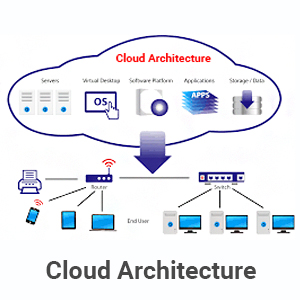


With the advancements in technologies, cloud computing has become one of the most trending platforms which are driving the world in recent times. Cloud is everywhere, may it be your mailbox, dropbox, google drive, e-commerce applications, or bank transactions. Public internet or digital networks are responsible to deliver cloud computing resources. Users can access these applications through mobile or desktop devices.
Most of the businesses are implementing cloud computing due to its numerous benefits such as reduced capital, on-demand self-service, security, and high productivity.
To identify how individual technologies are combined to form a unified cloud infrastructure, you need to first understand the blueprint of it i.e. cloud computing architecture. It shows how all the units and means, necessary to build a cloud infrastructure are integrated to develop an online virtual platform to perform computing operations.
In cloud computing architecture, all the data is accessed through a network from a specific geographical location called cloud. Whereas this infrastructure is handled by different organizations called as Managed Service Provider (MSP), Cloud Service Provider (CSP). An individual or organization can store, connect and retrieve their entire information from the cloud, irrespective of its geographic location
Cloud Computing architecture consists of mainly coupled essential components and sub-components for seamless computing operations. These components are
Fig 1: Cloud Computing Architecture
This architecture helps us to understand, how the cloud computing resources are being shared via Front End. It is the visible interface to the customers, clients, and users along with the client’s network-enabled devices that are used to access the cloud environment. Front end architecture is divided into three parts
Web Browser-It enables cloud computing software to run user terminal taking the face of a web browser or a client application.
Google Doc - A user can directly interact with the cloud through user interface via Gmail, Google Doc, or a text editor.
Client PC and Networks-These are connected part of Front end that includes user’s PC and other input devices along with internet connections/ to perform computing on cloud.
Different cloud computing system utilizes different interfaces, you can choose from the variety of web browsers such as Chrome, Safari, Firefox along with google docs. The front-end platform comprises thin and fat clients, tablets, and mobile devices, where most of the IT professionals communicate with each other and with clouds.
An Ideal backend architecture always empowers its front end as it embraces the entire infrastructure on the cloud.
The cloud computing backend architecture is managed by cloud service providers which are located on remote servers. They are usually composed of a physical assembly of four layers starting from application, platform, infrastructure, hardware along with security and management software.
Application layer: Application layer is known as software as a service which is one of the vital parts of cloud computing architecture. This topmost layer can be any software application or web service supported by SaaS that takes care of the client’s requests and requirements. This Application layer is nothing but the distribution prototype where a third-party host application and makes them available to users over the internet. SaaS removes expenses & requirements of hardware, maintenance, licensing, installation, and support.
Platform Layer: This layer comprises OS and apps to provide a PaaS platform for software development and deployment important for seamless cloud computing operations.
Infrastructure Layer: This layer includes storage units (CPU, Motherboard, Graphics Processing Unit (GPU), VMs, virtualization software, and servers on the IaaS platform that drives entire cloud software services on host application and network-level. System Administrators can access this scalable storage and compute power whenever needed.
Hardware Layer: This is the bottom-most layer in cloud architecture, primarily consists of all the aspects that can be physically managed such as database server, routers, switches, memory disk to control hardware configurations, fault tolerance along with power supply and traffic management.
Management: The management software is used to allocate resources to specific tasks and manages the seamless functioning of the cloud environment. It acts as a mediator that coordinates between frontend and backend architecture in a cloud computing system.
Security: Security is a critical component of any cloud computing infrastructure. Security keeps the debugging process aligned to cope up with the security issues. To ensure security in a cloud computing system, regular storage backup is the first step, whereas virtual firewalls are other elements to maintain cloud security.
The cloud computing architecture is very lucid and economical with its embedded components and free availability.
A cloud computing architecture is essentially a building block of IoT (Internet of Things), where all the applications and operations are controlled and managed by the cloud server.
It reduces the cost and simplifies the implementation and delivery of cloud services. The entire zest coming from cloud computing architecture is that it is developed to work as a service that is capable to bring huge transformation in the IT industry making it more feasible for developers not to depend on hardware to deploy their services.